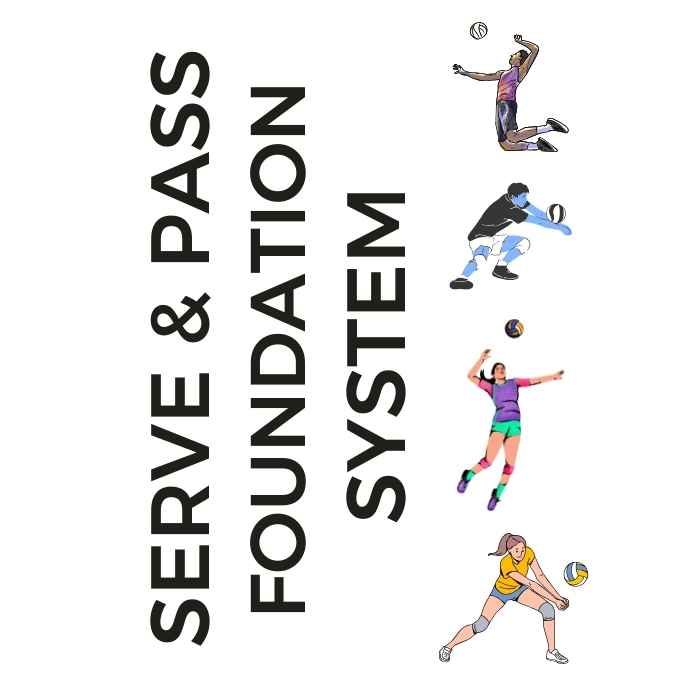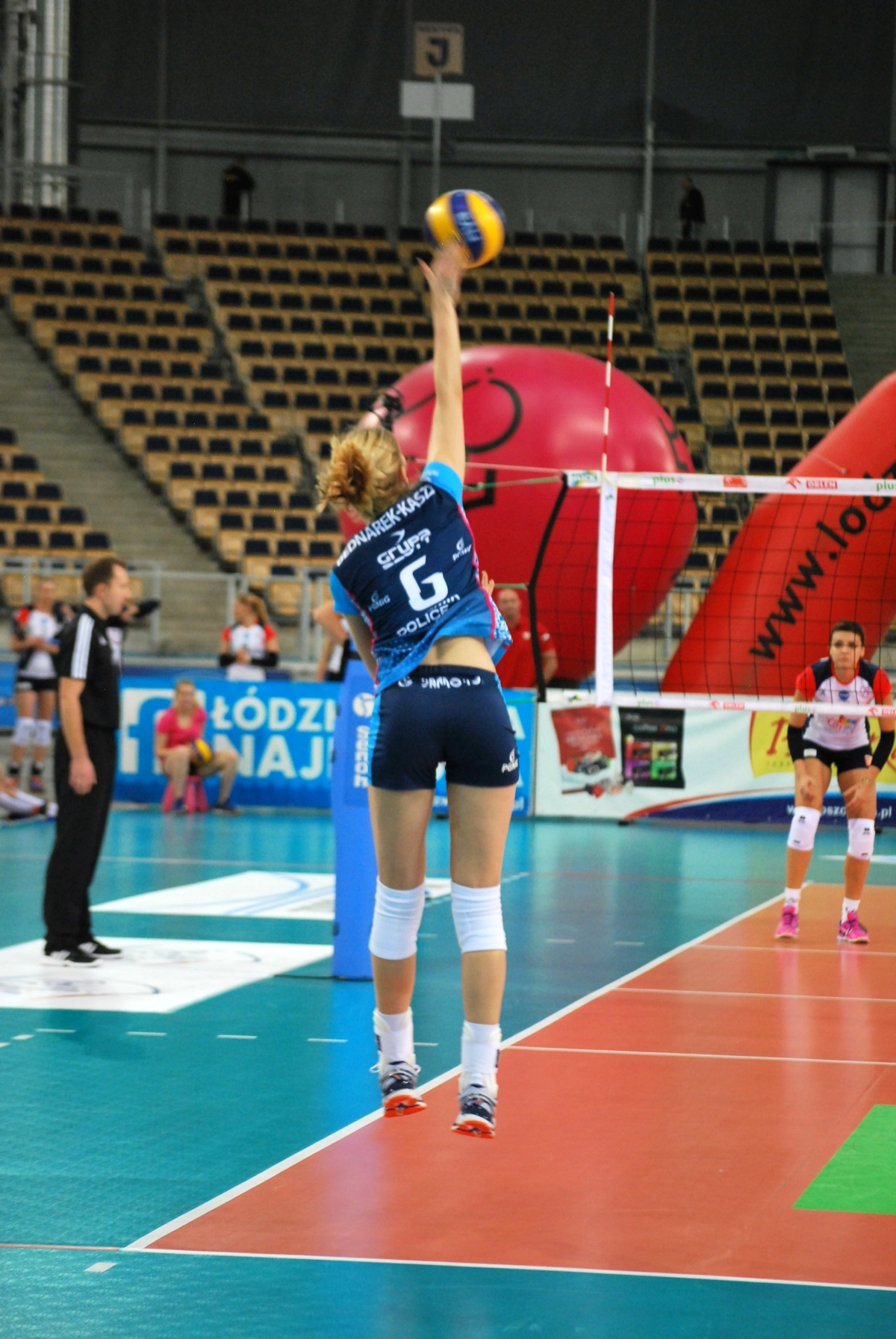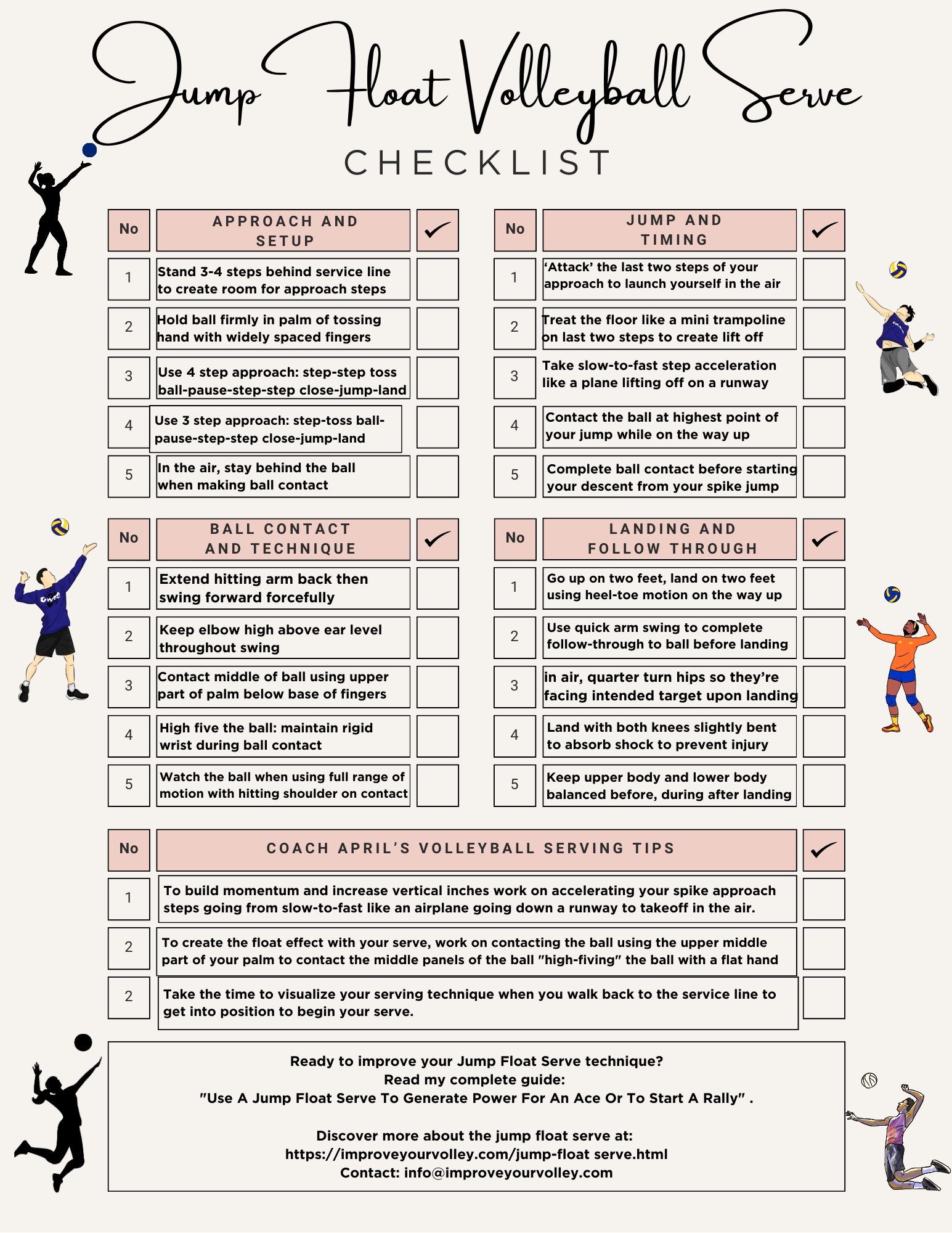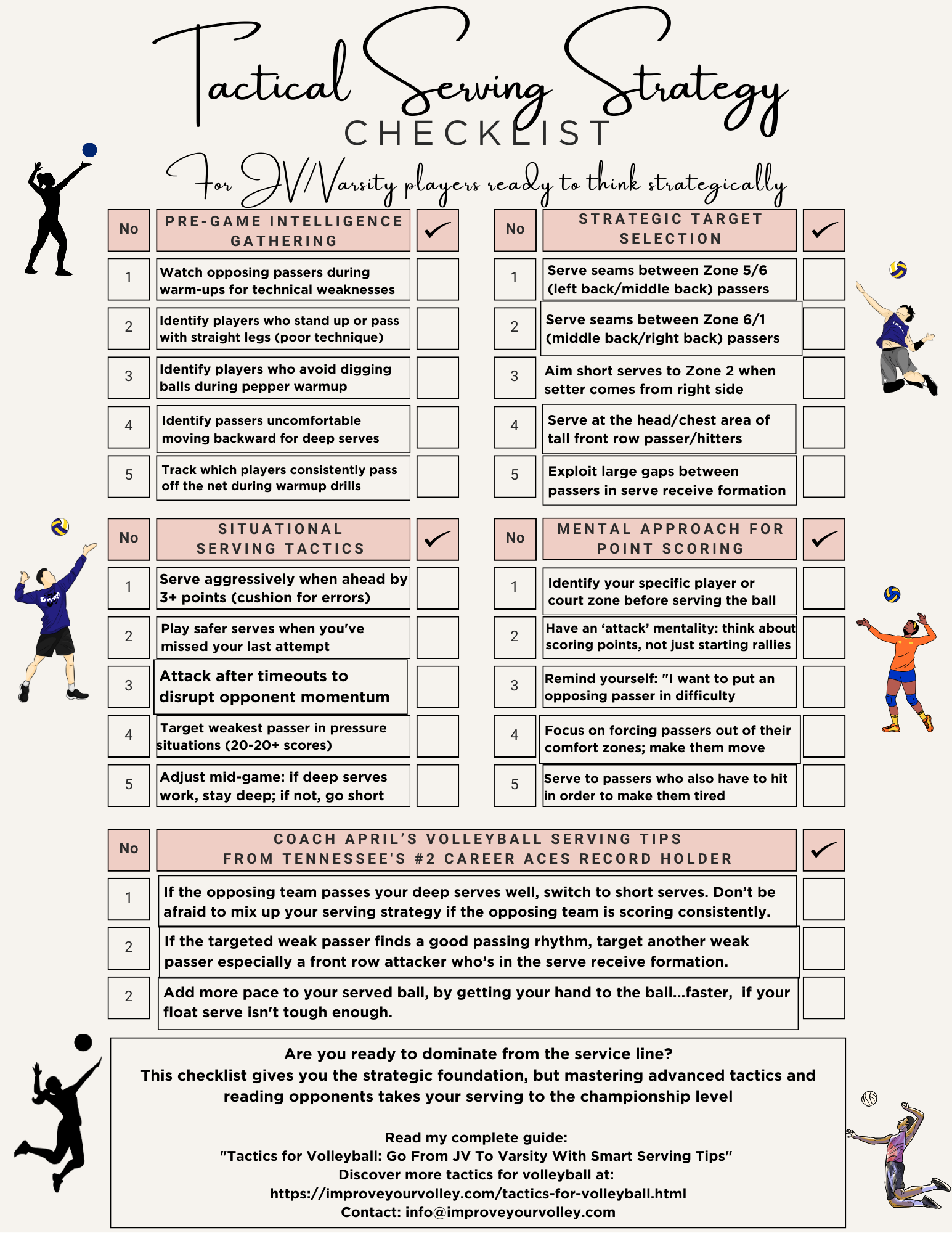
Serve + Pass Foundation System: The Complete Skills Arsenal The two-skill mastery system that transforms inconsistent players into the athletes coaches build their lineups around. Stop Struggling With The Two Most Important Skills In Volleyball!
- Improve Your Volleyball with Coach April
- Learn How To Coach Girls Volleyball
- The Let Serve Volleyball Definition
The Let Serve Volleyball Definition Is DeMystified For Serving Success
Discover the let serve volleyball definition in my comprehensive guide. Learn how excitement and strategy adds to the game with practical examples and trivia.
Attention to detail. Consistency. Focus-Driven Work. 🏐
These are the processes that we preach to our SQUAD every practice.
We believe in quality of repetition over quantity.
We teach our athletes to be disciplined and process oriented.
Because it’s the little things that set apart the average from the great.
If you can’t win the serve you can’t win the point.
While there is a time that we work on tops spins and developing power to drill down our opponent in our serves, we also emphasize with our boys that the most dangerous weapon is consistency.
Master the basics first. Only then will you open the door to new tools and possibilities.
Welcome to my comprehensive guide on the let serve in volleyball!
On this page, I explain the definition of the let serve and examine the various scenarios that demonstrate its application in different game situations.
Understanding the let serve rule is essential for players and spectators alike, as it adds an element of excitement and strategy to the game.
Addi works on her jump float serve toss consistency while aiming for a deep line serve to Zone 5.
By the end of this comprehensive guide, you will have
- a solid understanding of the let serve in volleyball
- its application in different scenarios
- its impact on gameplay strategies
Additionally, you'll have some fun let serve trivia to entertain your friends and enhance your appreciation of this fascinating aspect of the game.
Let's explore the world of the let serve volleyball definition together!
The Let Serve Volleyball Definition
The let serve has become a unique and important part of volleyball serving.
This rule allows for continuous gameplay, as the play continues uninterrupted until the ball falls to the floor within the opposing team's court.
The let serve rule offers the receiving teams an opportunity to adapt to unexpected ball bounces and net touches and still make strategic plays.
Listen to what I tell Addi about being aggressive with her armswing.
Working on her floater in volleyball serve today we did 100 reps of the same serve to the same spot so we could problem solve and work on every body part movement...where things go so when its time to do everything faster...we have smoothed out and understood all the possible wrinkles.
By exploring different scenarios where a let serve could occur, you learn how to appreciate the impact it has on gameplay strategies, creating challenges and opportunities for players on both sides of the court.
Incorporating Let Serves into Serving Strategies
The examples I provide, such as the
- quick serve
- skillful angle
- challenging float serve
- nerve-wracking match point
demonstrate how the unexpected trajectory and bounce of the let serve can disrupt the receiving team's serve reception strategies, creating opportunities for the serving team.
Zorro2212, CC BY-SA 4.0, via Wikimedia Commons
By using let serves intentionally or adjusting to unintentional let serves, players can keep their opponents guessing and can maintain an edge in the game.
The Let Serve Volleyball Definition
How Can The Let Serve Rule Be Applied? Scenarios and Strategies
To further solidify your understanding here are a few examples and scenarios where a let serve may occur.
These practical illustrations will demonstrate how the let serve rule is applied in different game situations and its impact on gameplay strategies.
The Let Serve Volleyball Definition
The Quick Serve
In a fast-paced match, a server quickly tosses the ball and executes a powerful serve.
However, due to the speed and minimal margin for error, the ball grazes the top of the net.
Despite the contact, the ball manages to clear the net and lands within the opposing team's court, resulting in a let serve.
The Let Serve Volleyball Definition
The Skillful Angle
A server can intentionally use a technique known as the "let serve angle."
By adjusting your arm swing and direction of the serve, to aim to hit the net at a specific angle that causes the ball to gently roll over and fall into an empty area of the opposing team's court, making it difficult to get to it in time to pass effectively.
This intentional let serve tactic adds a strategic element to the server's game plan, using the element of surprise and precision to gain an immediate advantage.
The Let Serve Volleyball Definition
The Challenging Float Serve
Usually done on purpose during a high-level match with experienced players, when a server executes a low and flat float serve that has an unpredictable trajectory.
As the ball gets close to the net, it lightly brushes the net and while it continues its path over the net, it falls into the opposing team's court.
A very smart and skillful serve specialist (like Tatoo the Volleybragswag White Tiger serving specialist below) knows how to use the float serve, combined with the let serve, to make it challenging for the receiving team to accurately judge where the ball will land in their court, which leads to errors in reception or creates opportunities for the serving team to easily run an offense in order to execute a powerful counterattack.
The Let Serve Volleyball Definition
The Nerve-Wracking Match Point
In a tense situation where the serving team is at match point, the server prepares to deliver a crucial serve.
As the server strikes the ball, it hits the top of the net but manages to trickle over and fall within the opposing team's court.
The serving team retains the opportunity to continue the rally and secure the victory, while the receiving team must regroup and respond with resilience.
Incorporating Let Serves into Serving Strategies
As I examine various let serve scenarios, we will uncover how players can strategically incorporate let serves into their serving strategies.
The examples provided, such as
- the quick serve
- skillful angle
- challenging float serve
- nerve-wracking match point
demonstrate how the unexpected trajectory and bounce of the let serve on the net can
- disrupt the receiving team's reception
- creating advantageous opportunities for the serving team.
By using let serves intentionally or adjusting to unintentional let serves, players can keep their opponents guessing and maintain an edge in the game.
The intentional (and unintentional) let serves contribute to the unpredictable and dynamic nature of the game.
This forces players to adapt and anticipate unexpected ball bounces on the net, so passers in serve receive and front row hitters waiting to run offensive plays need to adjust their tactics accordingly.
10 Fun Facts About The Let Serve Volleyball Definition
To add an extra layer of excitement, I share some fun let serve trivia and fun facts.
Follow along as I
- explore the connection between the let serve rule in volleyball and other racket sports like tennis and table tennis.
- highlight the use of the term "let net" to refer to the top edge of the volleyball net
- show you how the let serve brings an element of unpredictability to the game
- talk about how professional players (myself included) practice and strategically utilize let serves to gain an advantage
Let's gooo...
1. Fun Fact: The let serve rule is not unique to volleyball;
.....it is also in other racket sports like tennis and table tennis.
Does anyone know if there's a let serve rule in paddle ball?
2. The Let Net: Did you know that the top edge of the volleyball net is often referred to as the "let net?"
This term emphasizes an association with the let serve rule and the potential for the ball to make contact with the net during the serve.
3. Let It Hit!:
The let serve adds an element of unpredictability to the game because it challenges both the serving team and the receiving team to adjust quickly to the altered trajectory, bounce, and speed of the ball after it travels out of the server's hand.
This variability keeps players on their toes and adds excitement to the match
4. Did you know that professional players often practice controlling let serves as part of their serving repertoire?
I use to do this on purpose in my serving practice I'd purposefully adjust my arm swing so my standing float serve would be angled so it'd regularly nip the net on the way over to the opposing team's court.
Pro players aim to strategically exploit the unpredictable nature of let serves in order to disrupt the opposing team's reception and gain an advantage on the court.
5. Let serves can create a psychological challenge for the receiving team.
The unexpected bounce and spin of the ball can momentarily throw off passers, making it more difficult to accurately predict its flight path.
Skilled servers with a knack for let serves can use this psychological advantage to keep their opponents off balance.
Click to Download Your Jump Float Volleyball Serve Mastery Checklist pdf:
🎯Jump Float Volleyball Serve Mastery Guide - $7
Are you attempting jump float serves but lacking the technical precision that creates consistent power and accuracy? Why Struggle with Jump Float Serves When You Could Master Them Systematically?
You'll Get:
Approach and Setup Methods --Master 3-step and 4-step approaches with optimal spacing and ball positioning
Jump and Timing Techniques -Perfect the slow-to-fast acceleration that creates maximum vertical lift and power
Ball Contact Fundamentals Learn the "high five" contact method for consistent float effect and accuracy
Landing and Follow-through Execute safe two-foot landings with proper hip rotation and shock absorption
Click to Download Your Tactical Serving Strategy Checklist pdf:
🎯Tactical Serving Strategy Checklist Guide - $7
Are you serving without strategic purpose while opponents easily run their offense? Why React to Opponents When You Could Be Controlling Them?
You'll Get:
Pre-game intelligence methods --Identify technical weaknesses and poor passing habits during opponent warm-ups
Strategic target selections Master seam serving and zone targeting that creates immediate passing problems
Situational serving tactics Know when to serve aggressively vs. safely based on score and game situation
Mental approach strategies Develop point-scoring mentality and force passers out of comfort zones
Coach April's tactical tips Adjust serving strategy mid-game and target front-row hitters effectively
1-page PDF checklist Convenient format you can print or keep on your device for strategic reference
Click to Download Your Consistent Toss Mastery Checklist pdf:
🎯Consistent Toss Mastery Guide - $7
Are inconsistent tosses sabotaging your serves and forcing you to chase the ball? Why fight your toss when you could master the foundation of every great serve?
Do You Follow Me on Pinterest?
Follow me on Pinterest Volleybragswag to improve your game even faster!
I share alot of individual, partner and easy-to-do volleyball serving drills we do in class with my followers.
Many of these volleyball practice drills you can do at home by yourself or try at your next practice with your teammates.
If you're a B team or JV player trying to make varsity next year...your goal should be to complete 1000 reps a day of at least three of the basic skills on your own...volleyball passing, serving and setting should be at the top of the list.
If your athlete struggles with consistent serve receive, gets subbed out, or is overlooked for playing time—this is the fix you’ve been looking for.

Struggling with passing consistency?
I help talented passers tired of getting pulled from games because of inconsistent serve receive skills BUILD passing confidence without expensive private lessons using the same 3-step system that's helped dozens of my athletes get recruited.
Download my eBook for $17.99 and start building the passing confidence that keeps you on the court—and gets you seen by college coaches.
From Lady Vol to Legend: Coach April Produces Powerful Passionate Players...is that you?
What Are You Looking For?
Click to Download Your Pre Serving Ritual Mastery Checklist pdf:
🎯Volleyball Pre Serving Ritual Guide -
Players! Learn How To Transform Your Serve from Weak to Weapon
Click to Download Your Parent's Volleyball Serving Checklist pdf
🎯Parent's Volleyball Serving Checklist Guide
Parents! Help Your Player Develop Championship Serves (Even If You've Never Played)

Hi there!
Thanks for stopping by. Hope you learned something today that will help you reach your volleyball goals.
Be sure to subscribe to my email newsletter so you can learn more each week!
Stay strong! Stay motivated!
-Coach April

SUSCRIBE to my email newsletter below!
 Click to learn more about the weekly volleyball classes and clinics or email info@imrpoveyourvolley.com for information
Click to learn more about the weekly volleyball classes and clinics or email info@imrpoveyourvolley.com for informationCongratulations to my seven Boys-18s Vegas Volley club players who played in two state championship finals yesterday, the 3A and 5A State champinship finals at Sunrise Mountain High School.
TOURNAMENT CHAMPIONS!
A-1 Vegas Volley VBC
In It To Win It Tournament
May 2 - 4, 2025 Tournament
Gold Medalists
18s Premier Division
Vegas Volleyball's Unsung Heroes: Celebrating Moms with Peace Love Volleyball Shirts
Ready to energize your volleyball mom journey?
Subscribe to my 'Producing Powerful Passionate Peaceful Players' email list above on ImproveYourVolley.com.
You'll receive energy-boosting tips, exclusive insights from me, Coach April Chapple on maintaining momentum in volleyball.
Let's power up the Vegas volleyball scene together!
Recent Articles
-
3 Beach Volleyball Hand Grips How Do You Hold Your Hands When Passing?
Dec 20, 25 05:32 PM
The purpose of the volleyball hand grip you use to pass a ball is to help keep your elbows straight and to insure you have a very flat and wide a platform. -
5 Essential Serving Tips from Tennessee's #2 Career Aces Record Holder
Dec 09, 25 11:39 PM
I've identified the 5 essential serving tips that separate confident servers from struggling ones and you'll serve with the confidence that creates aces -
The Volleyball Toss How Consistent Is Your Ball Toss Before You Serve?
Dec 07, 25 12:29 AM
The volleyball toss for the overhand serve needs to consistently be two feet up in the air and one foot in front of front foot which puts the ball in front of your serving arm.


















































